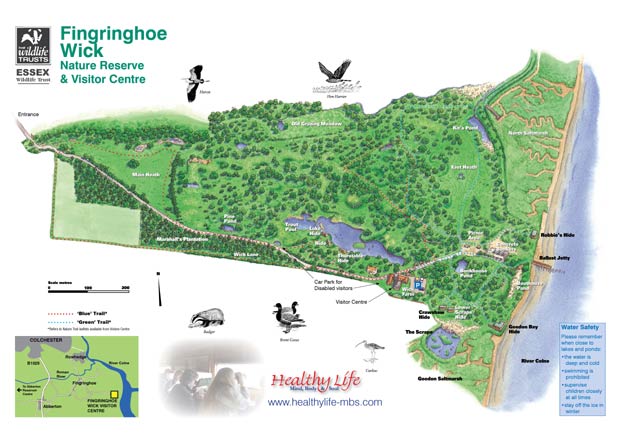Fingringhoe Wick Nature Reserve - Healthy Life Essex
Home » Articles » Outdoor Life » Countryside in Essex » Country Parks & Nature Reserves » With Visitor Centres » Fingringhoe Wick Nature Reserve
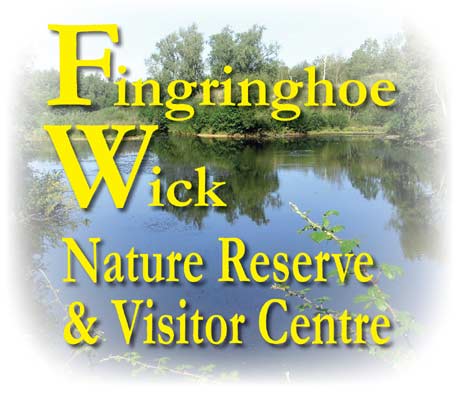
120 Acres of Wildlife, History and Tranquility.
Situated east of the B1025 mid way between Colchester and Mersea Island is Fingringhoe Wick, a fascinating and stunning site quite justifiably described as Essex Wildlife Trust’s flagship nature reserve. A little bit off the beaten track, but well worth the visit !
Lying on the banks of the river Colne, Fingringhoe Wick provides perhaps one of the finest landscapes in Essex. It overlooks a panorama of saltmarshes and farmland that stretches south to Mersea Island. The Colne estuary lies at its heart: glittering blue in summer, cold grey in winter, and the salty home of teeming coastal wildlife – a bird lover’s paradise!
| Open a larger scale copy of this map in Adobe pdf format |
It was once a farm, then worked as a gravel pit for forty years. In 1961 the Trust inherited this barren moonscape. But bare gravel, clay, mud and sediments are inviting seedbeds for wild plants, and today the undulating terrain is largely buried in woodland, thickets, dense scrub, ponds and a large lake. With the river frontage providing additional habitats such as saltmarsh, foreshore and inter-tidal mudflats, The Wick has become a magical place for both people and wildlife.
FLORA AND FAUNA
This wonderful bird watchers paradise is well served with hides overlooking both the lake and the river Colne. Over 200 species of birds have been recorded, of which 50 species nest each year.
Nightingales, the most romantic of birds, have been visitors at The Wick for forty years. Nightingale Walks take place the first two weeks of May. This year there will probably be about 25 singing 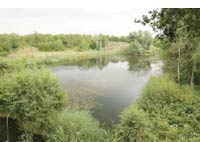 males filling the air with their awe inspiring song– but will you be lucky enough to see one?
males filling the air with their awe inspiring song– but will you be lucky enough to see one?
Watch the ponds for the darting blue flash of a kingfisher. Kestrels nest here, as well as tawny owls, little grebes and sparrowhawks. Between June and September, migrant waders 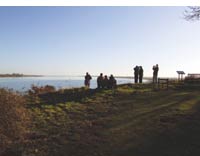 find the Scrape attractive. The estuary, quiet for much of the year, comes alive in autumn and winter with thousands of wildfowl and waders moving in and out on the tides, with the resident Marsh Harriers keeping a watchful eye on proceedings. They rely on the expanses of mud and saltmarsh for food or for roosting. This includes up to 700 avocets, viewable from the shore hides. Sea duck can be seen in mid-river.
find the Scrape attractive. The estuary, quiet for much of the year, comes alive in autumn and winter with thousands of wildfowl and waders moving in and out on the tides, with the resident Marsh Harriers keeping a watchful eye on proceedings. They rely on the expanses of mud and saltmarsh for food or for roosting. This includes up to 700 avocets, viewable from the shore hides. Sea duck can be seen in mid-river.
You will see many rabbits and grey squirrels, and maybe a fox. There are regular sightings of brown hare, stoat and weasel. And watch out for common seals in the estuary.
Spring and summer will see wild flowers bloom in abundance such as spring beauty, bird’s eye speedwell, common spotted orchid, bee orchid, sea lavender, and common glasswort. At least 350 species of flowering plants have been recorded. The shaded, humid conditions in the thickets suit  ferns, mosses and lichens. Visit in spring for tiny unobtrusive clovers, medicks and trefoils. Summer is best for colourful species, especially sea lavender on the saltmarsh, and masses of dog roses. The second half of the year provides rich colours of autumn berries and fungi: blackberries are always a popular snack for the mysterious badgers.
ferns, mosses and lichens. Visit in spring for tiny unobtrusive clovers, medicks and trefoils. Summer is best for colourful species, especially sea lavender on the saltmarsh, and masses of dog roses. The second half of the year provides rich colours of autumn berries and fungi: blackberries are always a popular snack for the mysterious badgers.
The Wick teems with insect life. The dragonflies and damselflies are renowned, adding to the colourful wildlife of Fingringhoe: thirteen species breed on the reserve. Many common butterflies flourish, together with the more localised green hairstreak. The sandy, eroding cliff faces are attractive to many bees, ants and wasps. Strangely, frogs are almost unknown at The Wick, although there is a tiny breeding population of toads. Common lizards, slow worms, and smooth newts are abundant. Great crested newts, adders and grass snakes are reported regularly.
The Visitor Centre
The Visitor Centre, originally opened in 1975, was refitted last year. It is spacious, light and airy and a warm welcome awaits you from the team of volunteers that assist with the day to day running 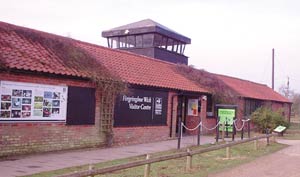 of the centre. This, of course, includes helping visitors with information about the many trails around the reserve, and information about the latest sightings of wildlife.
of the centre. This, of course, includes helping visitors with information about the many trails around the reserve, and information about the latest sightings of wildlife.
The gift shop has a wide range of merchandise from greetings cards to binoculars. Light refreshments and drinks are also available.
Walk from the shop and into the observation room and the panoramic view is stunning. Also, you will find informative panels on the gravel workings, wildlife and a fascinating timeline that starts at 55 million years ago. Coffee tables and comfy chairs offer a chance to pause and watch the birds on the feeders outside. During the spring there is a nest box camera in operation. There is also a viewing tower with 360 degree views of saltmarsh, lake and wildlife garden.
Being launched this Easter is a brand new family hands on activity “Panning for Gems”. It is being installed next to the visitor centre and will be undercover. This will be available to visitors during centre opening hours.
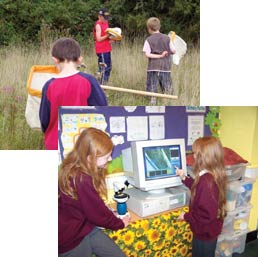 The visitor centre has a busy programme of events for the year ahead, which includes Nightingale Walks, Art Workshops and Spring and Autumn Open Days. The visitor centre welcomes group visits to the site, but requests advance booking.
The visitor centre has a busy programme of events for the year ahead, which includes Nightingale Walks, Art Workshops and Spring and Autumn Open Days. The visitor centre welcomes group visits to the site, but requests advance booking.
EDUCATION
Fingringhoe Wick offer a wide range of formal and informal education activities throughout the year, including school visits which have activities tailored to the national curriculum and other syllabi, school holiday activities which include Wildlife Discovery Day for 8 – 12 year old or Family Nature Days for under 8yrs accompanied by an adult, and birthday parties with favourite activities such as pond dipping, crabbing, mini beast hunting. (certain activities depend on season and tides).
Disabled facilities
The visitor centre is designed for the convenience of the elderly and visitors in wheelchairs. Some of the trails near to the centre are also marked suitable for the disabled, although in bad weather they may be a little difficult. Unfortunately, due to the undulating nature of most of the site, access to the foreshore and woodland areas may be limited.
Dogs are restricted to certain areas and must be kept on a lead

‘Island of Wildlife’
When visiting The Wick, why not purchase a copy of ‘Island of Wildlife’ The story of Fingringhoe Wick. Written by Laurie Forsyth (see book reviews).
Location, opening Times and contact details:
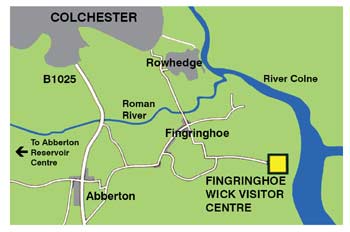 HOW TO FIND US
HOW TO FIND US
BY ROAD: Three miles south-east of Colchester, signposted from there with brown Nature Reserve signs. Take the B1025 from Colchester towards Mersea for three miles. After crossing the Roman River turn first left and follow the signs to the Reserve. (See map).
Opening Times:
Tuesday to Sunday: 9am – 5pm
Bank Holidays: 9am – 5pm
Closed: Mondays, Christmas Day & Boxing Day
 For further information on events and children’s activities contact the centre on
For further information on events and children’s activities contact the centre on
01206 729678
or visit the web site: www.essexwt.org.uk

